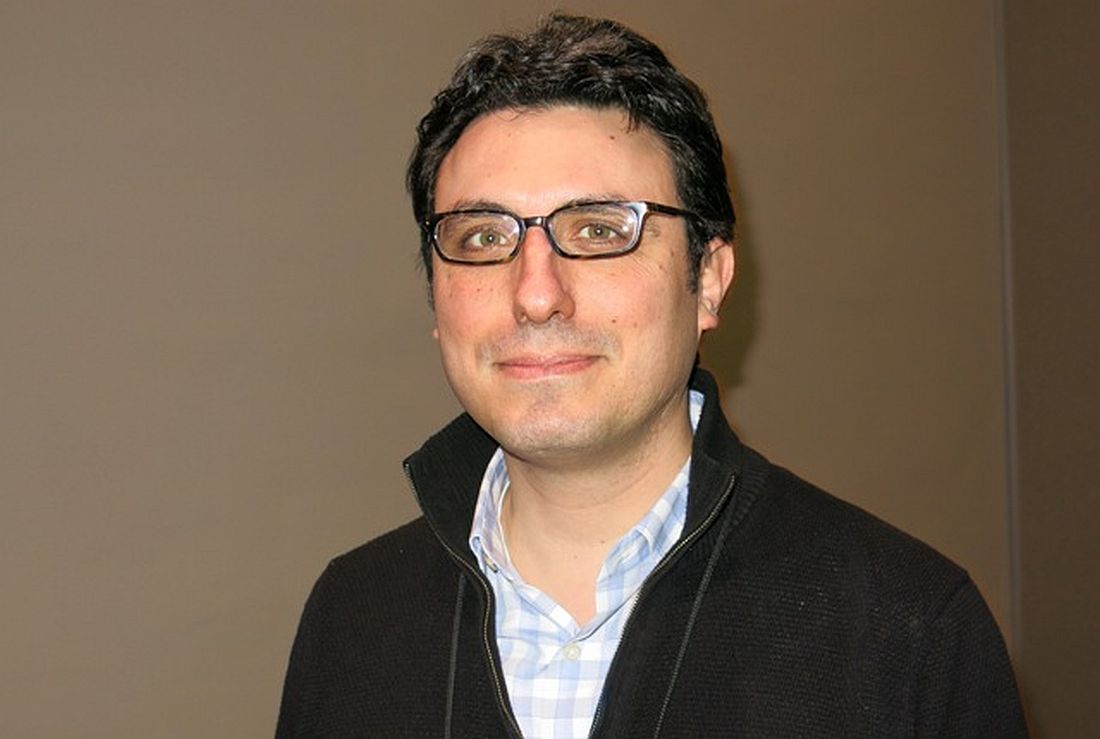User login
WASHINGTON – Sepsis and septic shock patients treated within 3 hours had lower in-hospital mortality rates than those treated between hours 3 and 12, based on data from nearly 50,000 adult patients. The findings were presented at an international conference of the American Thoracic Society and published simultaneously in the New England Journal of Medicine.
“Considerable controversy exists about how rapidly sepsis must be treated,” wrote Christopher Seymour, MD, of the University of Pittsburgh, Pennsylvania, and his colleagues. The researchers reviewed data from New York State, where hospitals have mandated protocols for sepsis treatment, to assess the impact of treatment timing on risk-adjusted mortality (NEJM. 2017. doi: 10.1056/NEJMoa1703058).
The primary outcome was in-hospital mortality, and each hour taken to complete the 3-hour treatment bundle was associated with increased mortality (odds ratio, 1.04 per hour). Overall, patients whose 3-hour treatment bundle was completed between 3 and 12 hours after hospital admission were 14% more likely to die than those who received the treatment bundle within 3 hours.
“These associations appeared to be stronger among patients receiving vasopressors than among those who were not receiving vasopressors,” the researchers noted.
On average, patients received the complete 3-hour treatment bundle in 1.30 hours, antibiotics in 0.95 hours, and a fluid bolus in 2.56 hours.
Odds of risk-adjusted in-hospital mortality were significantly higher for those with a longer time to completion of the 3-hour bundle within 12 hours (OR, 1.04) and for those with a longer time to administration of antibiotics (OR, 1.04); however, the time to bolus of IV fluids did not significantly impact in-hospital mortality.
The study was limited as a review and not a randomized trial and by a lack of data on the appropriateness of broad-spectrum antibiotics, the researchers said. However, the data suggest that, if there is a causal relationship between treatment timing and mortality, “prompt recognition and faster treatment of sepsis and septic shock in the context of emergency care may reduce the incidence of avoidable deaths,” they said.
Lead author Dr. Seymour reported grants from the National Institutes of Health and financial relationships with Beckman Coulter and Edwards Lifesciences.
“To improve outcomes of sepsis, policymakers are increasingly using regulatory mechanisms intended to provide incentives to clinicians and hospitals to improve the quality of sepsis care,” wrote Tina B. Hershey, JD, MPH, and Jeremy M. Kahn, MD, in an accompanying editorial. The regulations implemented in New York State in 2013 “mandate that all hospitals in the state use evidence-based protocols for sepsis identification and management and that they report to the state government data on their sepsis-protocol adherence and treatment outcomes,” they said. Although the regulations in New York are fairly new, the data show an increased used of protocols and reduced mortality, they noted. “However, several crucial questions remain, concerning not only the regulations’ specific impact but also the broader question of the value of statewide mandates for protocolized sepsis care,” they said.
Ms. Hershey and Dr. Kahn are affiliated with the University of Pittsburgh, Pennsylvania, in the department of health policy and management and the department of critical care medicine, respectively. Both Ms. Hershey and Dr. Kahn disclosed that their institutions have applied for federal grants to study sepsis policymaking and its impact on health care costs and outcomes.
“To improve outcomes of sepsis, policymakers are increasingly using regulatory mechanisms intended to provide incentives to clinicians and hospitals to improve the quality of sepsis care,” wrote Tina B. Hershey, JD, MPH, and Jeremy M. Kahn, MD, in an accompanying editorial. The regulations implemented in New York State in 2013 “mandate that all hospitals in the state use evidence-based protocols for sepsis identification and management and that they report to the state government data on their sepsis-protocol adherence and treatment outcomes,” they said. Although the regulations in New York are fairly new, the data show an increased used of protocols and reduced mortality, they noted. “However, several crucial questions remain, concerning not only the regulations’ specific impact but also the broader question of the value of statewide mandates for protocolized sepsis care,” they said.
Ms. Hershey and Dr. Kahn are affiliated with the University of Pittsburgh, Pennsylvania, in the department of health policy and management and the department of critical care medicine, respectively. Both Ms. Hershey and Dr. Kahn disclosed that their institutions have applied for federal grants to study sepsis policymaking and its impact on health care costs and outcomes.
“To improve outcomes of sepsis, policymakers are increasingly using regulatory mechanisms intended to provide incentives to clinicians and hospitals to improve the quality of sepsis care,” wrote Tina B. Hershey, JD, MPH, and Jeremy M. Kahn, MD, in an accompanying editorial. The regulations implemented in New York State in 2013 “mandate that all hospitals in the state use evidence-based protocols for sepsis identification and management and that they report to the state government data on their sepsis-protocol adherence and treatment outcomes,” they said. Although the regulations in New York are fairly new, the data show an increased used of protocols and reduced mortality, they noted. “However, several crucial questions remain, concerning not only the regulations’ specific impact but also the broader question of the value of statewide mandates for protocolized sepsis care,” they said.
Ms. Hershey and Dr. Kahn are affiliated with the University of Pittsburgh, Pennsylvania, in the department of health policy and management and the department of critical care medicine, respectively. Both Ms. Hershey and Dr. Kahn disclosed that their institutions have applied for federal grants to study sepsis policymaking and its impact on health care costs and outcomes.
WASHINGTON – Sepsis and septic shock patients treated within 3 hours had lower in-hospital mortality rates than those treated between hours 3 and 12, based on data from nearly 50,000 adult patients. The findings were presented at an international conference of the American Thoracic Society and published simultaneously in the New England Journal of Medicine.
“Considerable controversy exists about how rapidly sepsis must be treated,” wrote Christopher Seymour, MD, of the University of Pittsburgh, Pennsylvania, and his colleagues. The researchers reviewed data from New York State, where hospitals have mandated protocols for sepsis treatment, to assess the impact of treatment timing on risk-adjusted mortality (NEJM. 2017. doi: 10.1056/NEJMoa1703058).
The primary outcome was in-hospital mortality, and each hour taken to complete the 3-hour treatment bundle was associated with increased mortality (odds ratio, 1.04 per hour). Overall, patients whose 3-hour treatment bundle was completed between 3 and 12 hours after hospital admission were 14% more likely to die than those who received the treatment bundle within 3 hours.
“These associations appeared to be stronger among patients receiving vasopressors than among those who were not receiving vasopressors,” the researchers noted.
On average, patients received the complete 3-hour treatment bundle in 1.30 hours, antibiotics in 0.95 hours, and a fluid bolus in 2.56 hours.
Odds of risk-adjusted in-hospital mortality were significantly higher for those with a longer time to completion of the 3-hour bundle within 12 hours (OR, 1.04) and for those with a longer time to administration of antibiotics (OR, 1.04); however, the time to bolus of IV fluids did not significantly impact in-hospital mortality.
The study was limited as a review and not a randomized trial and by a lack of data on the appropriateness of broad-spectrum antibiotics, the researchers said. However, the data suggest that, if there is a causal relationship between treatment timing and mortality, “prompt recognition and faster treatment of sepsis and septic shock in the context of emergency care may reduce the incidence of avoidable deaths,” they said.
Lead author Dr. Seymour reported grants from the National Institutes of Health and financial relationships with Beckman Coulter and Edwards Lifesciences.
WASHINGTON – Sepsis and septic shock patients treated within 3 hours had lower in-hospital mortality rates than those treated between hours 3 and 12, based on data from nearly 50,000 adult patients. The findings were presented at an international conference of the American Thoracic Society and published simultaneously in the New England Journal of Medicine.
“Considerable controversy exists about how rapidly sepsis must be treated,” wrote Christopher Seymour, MD, of the University of Pittsburgh, Pennsylvania, and his colleagues. The researchers reviewed data from New York State, where hospitals have mandated protocols for sepsis treatment, to assess the impact of treatment timing on risk-adjusted mortality (NEJM. 2017. doi: 10.1056/NEJMoa1703058).
The primary outcome was in-hospital mortality, and each hour taken to complete the 3-hour treatment bundle was associated with increased mortality (odds ratio, 1.04 per hour). Overall, patients whose 3-hour treatment bundle was completed between 3 and 12 hours after hospital admission were 14% more likely to die than those who received the treatment bundle within 3 hours.
“These associations appeared to be stronger among patients receiving vasopressors than among those who were not receiving vasopressors,” the researchers noted.
On average, patients received the complete 3-hour treatment bundle in 1.30 hours, antibiotics in 0.95 hours, and a fluid bolus in 2.56 hours.
Odds of risk-adjusted in-hospital mortality were significantly higher for those with a longer time to completion of the 3-hour bundle within 12 hours (OR, 1.04) and for those with a longer time to administration of antibiotics (OR, 1.04); however, the time to bolus of IV fluids did not significantly impact in-hospital mortality.
The study was limited as a review and not a randomized trial and by a lack of data on the appropriateness of broad-spectrum antibiotics, the researchers said. However, the data suggest that, if there is a causal relationship between treatment timing and mortality, “prompt recognition and faster treatment of sepsis and septic shock in the context of emergency care may reduce the incidence of avoidable deaths,” they said.
Lead author Dr. Seymour reported grants from the National Institutes of Health and financial relationships with Beckman Coulter and Edwards Lifesciences.
Key clinical point: In-hospital mortality rates were lower for sepsis patients who were treated more rapidly (within 3 hours) with a 3-hour bundle of sepsis care and antibiotics.
Major finding: Sepsis patients whose 3-hour treatment bundle was completed between hour 3 and 12 were 14% more likely to die than those who received the treatment within 3 hours.
Data source: A review of data from 49,331 sepsis and septic shock patients at 149 hospitals.
Disclosures: Lead author Dr. Seymour reported grants from the National Institutes of Health and financial relationships with Beckman Coulter and Edwards Lifesciences.

